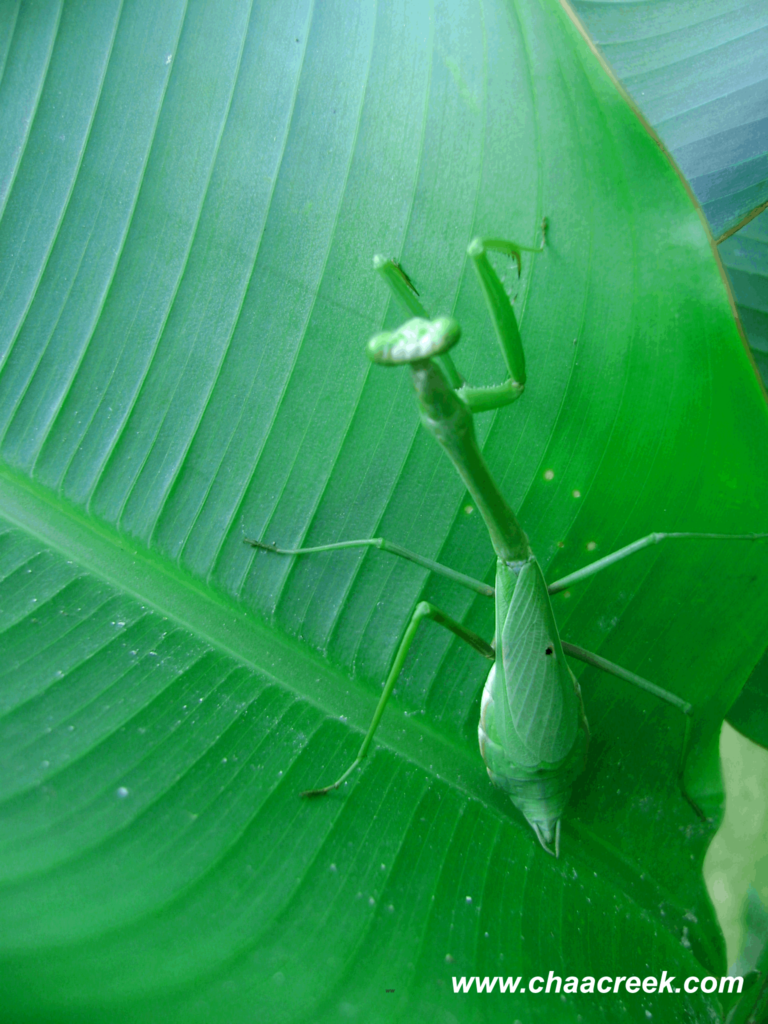Mantidae (also known as praying mantis) is the common name for an insect of the order Mantodea which are mostly tropical or subtropical. The insect is named after the distinctive way they hold their front legs up and together as in a prayer and in Greek the word “mantis” means prophet or fortune teller.
According to David Juarez, a Chaa Creek Naturalist Guide, Praying mantis can be found in all parts of the world with mild winters and sufficient vegetation.
In this blog post, David highlights 7 cool facts about the praying mantis.
1.) The praying mantis is a large insect that can be found in gardens and is a predatory species that is always on the prowl eating any insect that moves.
2.) The praying mantis has a triangle head with huge compound eyes and chewing mouth parts that swivels freely atop a long, narrow pro thorax ( first section of the thorax),which also carries the highly modified, grasping forelegs with their array of hooks and spines.
3.) Mantis are cryptically colored to be like the plant on which they lie in wait, and projections of the cuticles of the body and legs often enhance their likeness to bark, twigs, leaves or flowers.
4.) The diet of praying mantis consists exclusively of small insects, rodents, frogs and hummingbirds, however grasshoppers are more typical fare but a praying mantis will eat anything it can catch.
5.) Bushes are the preferred habitat for praying mantis, so landscapes that include plenty of shrubbery usually have an abundance of this predatory insect.
6.) A fascinating feature of the praying mantis is the fact that they are able to turn their head 180 degrees for excellent vision and hearing. The predators of the praying mantis are not limited to other animals because praying mantids will eat other mantids. This cannibalistic behavior is usually during the nymph stage and during mating, with the male likely to provide a feast for the female.
7.) The three most common species of Mantis are European Mantis, Chinese Mantis and Carolina Mantis. Of these, only the last is native to the continent – the European and Chinese species were introduced in the 20th century as predators in an attempt to control pest populations in gardens.
Praying mantis can be seen at Chaa Creek’s Maya Organic Farm or at the Maya Rainforest Medicine Trail.
Have you seen in a praying mantis in your garden? We would love to hear about your experience if you leave a comment below.

7 Cool Facts about the Praying Mantids http://t.co/OgmIy9mdQf
7 Cool Facts about the Praying Mantis http://t.co/OgmIy9mdQf via @chaacreek
Liked your article but it surprises me that the praying mantis is tropical or subtropical.. I live in Rhode Island and our winters are below freezing very regularly at times. I always spot them and many babies every year. Today is a chilly one here in RI, lows this AM in the 30’s an 40’s. I just took pictures of one in my back yard area. I’m still surprised and intrigued when I see them !! Just the color change is interesting to watch as they move from one area to another.